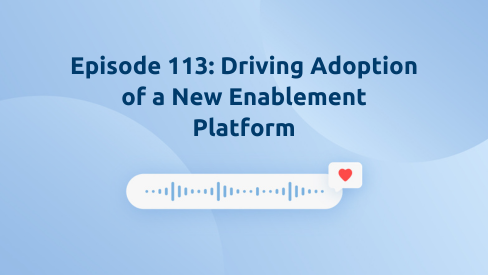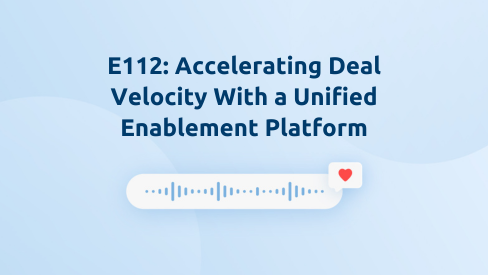According to Epsilon research, 80% of buyers report feeling overwhelmed by the amount of information encountered in the buying journey. So how can you effectively engage buyers to guide them through the journey in an effective manner?
Shawnna Sumaoang: Hi, and welcome to the Win Win Podcast. I’m your host, Shawnna Sumaoang. Join us as we dive into changing trends in the workplace and how to navigate them successfully.
Here to discuss this topic is Jason Larioni, the business development manager at Pie Insurance. Thank you for joining us, Jason. I’d love for you to tell us about yourself, your background, and your role.
Jason Larioni: My name is Jason Larioni. I am based in Scranton, Pennsylvania. I have been with Pie Insurance. For close to two years now started in the sales enablement role, got to build the vertical at Pie. It was really fun getting to dive in and really create what sales enablement was going to look like at Pie in the business development group.
So part of that journey was leveraging Highspot and getting that up off the ground. That was really exciting and a really intense time building what all of that would look like. And then also being responsible for an entire new system and all of that change management. And just over the last few months, I’ve transitioned into a manager role, managing a team of digital account specialists here.
And at Pie, I have an extensive background in training and enabling. I actually started my career as a high school English teacher. So that, you know, that drive to help people and educate and teach people and really kind of dive into what motivates people to learn and be better versions of themselves. I’ve always really loved tapping into that. I’ve taken a lot of that experience that I’ve had throughout my early career. I’ve taken that and implemented it into the role that I’m in now.
SS: Tell me more about that, Jason. As you mentioned, you’ve held a lot of different roles across the go-to-market organization. How does this experience, everything from client success to enablement to training, influence your current role as a development manager?
JL: Yeah, it’s interesting you bring that up, because I actually just talked to my direct manager about this yesterday. I really feel that, even though I may have said otherwise, I really feel like I was not ready for this manager or leadership role until now.
And I do attribute that to a lot of things. All of the experience that I’ve had throughout my career being in the different verticals, like you said, managing accounts as a client relationship manager, moving into the sales enablement role and wearing that hat, and I was doing sales enablement before it was even a thing or before that was a thing that people called it.
So to move into that and then really. Understand what helps reps be successful and and what helps them with their go-to-market strategy and influence that. I’ve really taken that into this role and I try to come at them with that lens as I’m managing and coaching and effectively helping them understand KPIs and all of that.
Where their struggles are. So it’s just, again, I’ve never really felt ready until I was able to bring all of those pieces together and have the experience that I’ve had. I’ve used that to influence the way I interact with my reps and move them forward.
SS: Amazing. Now. I’d love to get your perspective now as a sales leader. What would you say is the strategic value of enablement for sales teams?
JL: The list is endless, really. It’s so critical to have resources and a path to success for your reps. When I was a client relationship manager. We didn’t have it. There was nothing. We didn’t have a content management system. We didn’t have a learning platform.
We were a scrappy startup and it was all knowledge-based for the people that were there. It was all lived inside people’s brains. And when someone left, that walked out the door with them you could be losing years of experience or entire processes that no one else knew how to do. So, you know, when I got to come into Pie and help create that sales enablement strategy and what that would look like, I always kept that in the back of my mind of what I needed when I was in this role and it just, it gives the reps the ability to focus on what’s important and that is building relationships with their clients.
They know then that they have the tools in their toolboxes. They don’t have to think about those things. They don’t have to. Worry about, Oh, is this piece of content that I am going to be sending out accurate or up to date, or am I saying the right thing? With the content governance and all of the pieces of the puzzle that Highspot has brought in for us specifically, it allows the reps to just focus on selling while giving them tools to help sell better and build relationships better.
SS: I love that. Now, prior to Highspot, your team did leverage, I believe, another platform to try to equip your sales teams. What were some of the challenges your team faced at that time and what motivated you to change your tech stack?
JL: Yeah, so Highspot is something I’ve been interested in for years. At my prior employer, I fell in love immediately the first time I was pitched on it.
It’s just such a robust CMS and LMS involved or coupled with that. The driving factor was we were using Confluence, which I think a lot of organizations are using to help with their content management and it works really well for a product org, but there’s really no way to have content governance in there and I really was fitting a square peg into a round hole. For what I wanted it to do and how I wanted to segment different aspects of business development. We have different teams on here. Some information was relevant to some teams, some information was not relevant to other teams, and it didn’t allow me to get into the weeds the way that I needed to. I made it work for the beginning of the sales enablement journey, but I knew as we were scaling as an organization and as a business development group that we needed to have something more robust.
We needed to have something that was going to help us with our content governance and was going to help us go to market in a different way in ways that we hadn’t before. And the biggest selling point for me was those digital sales rooms because we do have a lot of really high-priority relationships.
We want that level of self-service. That we weren’t able to provide our agents before. And now with that Digital Salesroom, we can create that bespoke experience for our really great partners, our high-priority partners, the ones whose relationships are invaluable to us and we can help them be more successful with Pie.
We can help build that relationship more. They know to go there to look for new things. And that was a really big selling point. And one of the things that really got us excited about bringing Highspot on board.
SS: I love that. I want to dig actually into both of those points. On the governance side, your team has seen some drastic improvement. I think you guys have had a 35 percent boost in the last few months on the governance side. Can you tell us about some of the impact that an effective governance strategy has on your sales teams?
JL: Yeah, it’s been almost immediate we’ve seen the effects of it. I think with any organization that’s using Slack, there’s good and bad to using Slack and we’ve all seen it.
When I first started, there were a lot of processes and documents that lived in Slack, you know, whether it was pinned to a channel. Or, you know, you’d have to go into a group channel and say, Hey, I need this done. You can never quite know if what you were doing was the right way to do it, or if that document that was pinned was the most recent document.
You might have one downloaded on your desktop, or that one was pinned and you’re not sure which was the right one. And almost immediately, we saw that stop. Like, we unpinned everything from our channels, and we said, Hey, stop sending PDFs out to your partners that you’re working with. We’re going to leverage Highspot because you know that the link you’re sending is the most up-to-date version of that document.
That version history was a huge piece of it too, where you could just go in and update a version of the same document and then that link doesn’t change. To answer your question more specifically, we saw Slack usage decline significantly because the reps knew and continued to know that. The documents and the information and the processes and the SOPs that they’re looking at are correct and accurate because of the governance that we’ve instilled and been able to really drive home with Highspot.
SS: Amazing. And the other capability that you talked about that you felt was delivering value is Digital Rooms. I’d love to understand, how are you helping your teams better use the right content when they find it to engage clients through things like the Digital Room capabilities in Highspot?
JL: Yeah, so we started really simple. I created a template at first for them to use just a really high level. Hey, you can book a meeting here with me. Here are some successes that we’ve seen in your state. So that can help inform your decisions on what business you’re going to bring to us so that you are not wasting your time. Our general processes and procedures and how to interact with us.
And from there, it became a collaborative discussion of it. Let’s try things. I would meet with one rep and they’d say, Hey, I want to download this Salesforce report and have it automatically import into an Excel sheet that’s external facing. So my agent can view it and understand, okay, you know, I submitted this business.
Where’s it at in the funnel? I want to see how it spits out on the other side. And it’s giving them that real-time. And then we would come together as a group and all of those individual conversations that I had with different reps. And They would talk about this worked, this didn’t work. I want to try that.
And we would then piecemeal it together and it grew into something much bigger and more robust. And it became this collaborative discussion of what was working, and what wasn’t working. And now they’ve gotten better at it than I was even able to in the beginning. And they’re doing things with their digital sales rooms that I didn’t even dream possible.
So they were immediately excited about it. And I think that that was the big. The hurdle that I was worried about getting over was we had to have immediate buy-in. So that’s why I really wanted to start small with the digital rooms, and let them see the value. And then once we started sharing them with our partners, our partners started giving us feedback of, wow, this is incredible.
You guys were easy to use before, but this made it even easier to use now. We just got so much positive feedback. And once they saw that and we started sharing it, it was just game on. And everybody was like, wow. I want to do this. My team then started using it in a different way for new partner onboarding and everybody just got really creative and really excited about it.
And it was just, it exceeded my expectations of how we would adopt this product and it’s really exciting to see.
SS: I love that. And in addition to engaging new clients with digital rooms, I think you guys are also working on expanding relationships with existing partners and agencies as you’ve touched on a few times during this conversation. What are some of the key ways you’re supporting this initiative?
JL: Yeah, so that entire story I just told right there about the different ways, hey, I’m trying this, that was all current agencies. We weren’t even Using it for new agencies until a few weeks ago that came out of how we were using it with our current agency base so that was really again where I saw that gap of we’re not meeting the client’s needs the way we can be and I think I kind of shifted the direction of the The main purpose of a Digital Sales Room as like a new acquisition piece.
But I saw that ability for us to use it the way that we needed to. And that’s how we started with the current agency base. But we are continuously looking at those engagement factors and seeing what’s being looked at, how often it’s being looked at, who’s using it the most and maybe why they’re using it the most.
And we’re always sharing different reps of, Hey, this worked for me. This didn’t work for me. This is really what’s getting them engaged. So we’re making sure that, you know, we’re covering our bases there.
SS: Love that. Now, as a sales leader, what are some of your best practices to provide coaching to your teams in order to improve performance against a lot of those key initiatives that you’re focused on driving for the business?
JL: Yeah, one of the most important things for me is I really just want to foster a culture of feedback and learning. I want my reps to be able to come to me with ideas. We’re a tech-driven company, you know, we’ve got Highspot, we’re leveraging other platforms that help us automate a lot of our tasks that come out of Salesforce.
And a lot of what we do using Highspot, or using Groove, or using other technology platforms, a lot of that comes from ideas from my team. So yeah. They may come to me and say, Hey, I want to engage this group of people. And we’re, we’re trying to engage at scale. And we’re trying to talk to a lot of people at once.
And without that, that culture of feedback and learning and testing things out, what we’re doing wouldn’t work. And because of that, we’ve been able to be successful. We have failed. We’ve tried things that didn’t work. I’ve said, Hey guys, that didn’t work. What did we learn from that? And we’ve learned from our mistakes.
And when we do something similar. We try to do it better than before and hopefully get success out of it then. But specifically my team, we’re not afraid to fail. We’re not afraid to try new things. And we’re not afraid to, a lot of my reps say, Hey, I want to try this. Can you help me? And it’s been really rewarding coming into this role and having a group that is willing to try and is okay if they fail, but is also excited to learn from those failures.
SS: I love that. I think that’s a great culture to cultivate within your organization. How, Jason, do you think about leveraging data, though, to help optimize the performance of your teams? And do you have any wins you can share?
JL: Yeah, data is how we make most of our decisions. Honestly, we’re very state-specific with the type of business that we do.
So, trends in a state is very critical to how we go to market. So, for example, if we start to see a decline in submissions from our agency base, we’re gonna look at, okay, was it in a specific state? Was it in a specific class code? If it is in a specific state, What is happening? Where are our competitors at?
Did our competitors drop prices? Did we come in high? And we try to identify trends there. And that really informed a lot of, I just previously mentioned some of the things that we want to try and identify a group of agents, right? So we may say, Hey, things have been slipping in X state a little bit. Let’s engage the agency base there and understand what’s going on.
And maybe it’s just a lack of engagement. We just fell off on our engagement a little bit, but maybe there’s more to it. So. When we are doing a quote follow-up and we’re looking to understand, are you going to place this business with us or are you not, we can then get feedback on maybe it is pricing, maybe it’s something else.
So that data is really critical. And we’re constantly looking at trends in states, trends in class codes to help us inform how we want to go to market and engage at scale.
SS: I love that. That’s amazing. All right. Last question, Jason, as you plan for the future, how do you plan to continue to strengthen buyer engagement and drive revenue growth for your team?
JL: We just want to continue to leverage these incredible platforms like Highspot. And I think we’re only scratching the surface. We’ve backfilled my old position. We’re with someone fantastic. We have an incredible sales manager and the BD side of the house now. And she is just as excited, if not more excited about Highspot than I am.
So we really want to lean into what is working and how can we just continue to build on that. And like I said, we’re only scratching the surface with Highspot. We really want to continue to leverage our digital sales rooms, and leverage those sales plays. Make sure that we are building our content library. We want to continue to grow that library and really have every single SOP and process and anything that the reps could need to be successful. We want to make sure that we are giving that to them when they need it and it’s easy to find. So really just leaning into the things we’re already doing well and just doing more of it.
SS: Amazing, amazing job, Jason. Well, thank you so much for joining us today. I really appreciate the time, Jason.
JL: Yeah, thank you so much for having me. It’s been great.
SS: To our audience, thank you for listening to this episode of the Win Win Podcast. Be sure to tune in next time for more insights on how you can maximize enablement success with Highspot.



